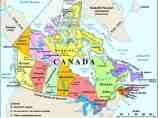Geography
The Great Lakes basin, which straddles the Canada-United States border, contains 18% of the world's fresh surface water and is home to almost a third of the Canadian population. According to Environment Canada the Great Lakes basin (the lakes plus the area of land draining into the lakes) is home to 8.5 million Canadians and 30.7 million Americans.
As well as providing drinking water, the lakes have played a major role in the development of both countries. They allow goods to be shipped to and from the heart of the continent; they are a source of hydroelectricity; and they are the site of industrial, commercial, agricultural, and urban development. The Great Lakes also provide an array of recreational opportunities.
The Great Lakes basin is a huge ecosystem. The specific problems in the Great Lakes have changed over time, but the broader issues have remained – those of deteriorating water quality through industrial and municipal uses, fluctuating water levels, flooding, and shoreline erosion. Other concerns are acid rain, airborne toxics, depletion of wetland areas, increased demands on the shoreline land base, the impacts associated with the unintentional introduction of exotic species, and climate change.
Canada has created the world's biggest freshwater reserve spanning more than one million hectares of Lake Superior.
